#nile river explorers
Explore tagged Tumblr posts
Text

2nd joint for ones Solar rising *ICE COLD ZEL FREESTYLE playing in the background*
#spiritualstoner#me#southfla#stoner#my pics#my gifs#browardcounty#cannabiscommunity#melanin#weedlovers#weed#explore#explorepage#denzel curry#heru#anubis#rawpapers#OnesSolarReturn#Nile River season
5 notes
·
View notes
Text

Gala Dinner Experience
Indulge in a Gala Dinner Experience with Savvy Travelers, savoring exquisite cuisine and entertainment!
#egypt nile river cruise#egypt nile cruise#luxurious nile cruise#nile river cruise#cairo exploration tour#pyramids giza visit#valley kings excursion#egyptian museum tour#alabaster mosque visit#sakkara necropolis tour#mena house experience#hatshepsut temple exploration#colossi memnon sightseeing#edfu temple discovery#aswan felucca ride#abu simbel excursion#cataract hotel tea#philae temple visit#nubian village tour#kom ombo visit#karnak temple exploration#luxor market shopping#hathor temple tour#dendara temple visit#abdeen palace tour#coptic cairo exploration#welcome reception cocktail#gala dinner experience#egyptologist guided tour#exclusive shore excursions
0 notes
Text
Journey Through Egypt: Exploring Cairo, Alexandria, and Beyond #writeapageaday @Blogchatter
Journey Through Egypt: Exploring Cairo, Alexandria, and Beyond #writeapageaday @Blogchatter #EgyptTravel #CairoAdventures #AlexandriaExploration #DesertSafari #HistoricalLandmarks #CulturalHeritage #AdventureTravel #TravelMemoir #AncientWonders #NileRiver
Exploring the Wonders of Egypt: A Personal Journey through Cairo, Alexandria, and Beyond Embarking on a journey to Egypt is like stepping into a living history book, where the tales of ancient civilizations come to life amidst the bustling streets and majestic monuments. As an avid traveler and lover of history, my most cherished holiday was undoubtedly my adventure through Cairo, Alexandria,…

View On WordPress
#Adventure Travel#Alexandria Exploration#Ancient Wonders#Cairo Adventures#Cultural Heritage#Desert Safari#Egypt Travel#Historical Landmarks#Nile River#Travel Memoir
0 notes
Text
Nile River & Sahara Dessert
“Exploring the Enchanting Trio: Nile River, Sahara Desert, and Giza Pyramid” Nile River: Flowing like the lifeblood of Egypt, the Nile River has been the cradle of civilization for millennia. Stretching over 4,000 miles, the Nile is the longest river in Africa and has played a pivotal role in shaping the destiny of the region. Its annual flooding, a result of the monsoon rains in the Ethiopian…

View On WordPress
#Ancient Wonders#desert Discovery#Desert Expedition#Egyptian Landmark#Nature#Nile Cruise#Nile Delta Marvels#Nile exploration#Nile History#Pyramid Architecture#Pyramid excursion#Pyramid Heritage#Pyramid Mysteries#River#Sahara adventure#Sahara Landscape
0 notes
Photo

Kom Ombo #luxor #egypt #nile #river #nightphotography #nikon #socnikon #d850 #24mm #nikkor #lens #igers #igerscatalunya #igerseurope #picoftheday #photooftheday #explore #globetrotter #architecture #archeology #instapic #instagood #ancient #ptolomaic (at Kom Ombo Temple) https://www.instagram.com/p/CpVosXusgsz/?igshid=NGJjMDIxMWI=
#luxor#egypt#nile#river#nightphotography#nikon#socnikon#d850#24mm#nikkor#lens#igers#igerscatalunya#igerseurope#picoftheday#photooftheday#explore#globetrotter#architecture#archeology#instapic#instagood#ancient#ptolomaic
0 notes
Photo
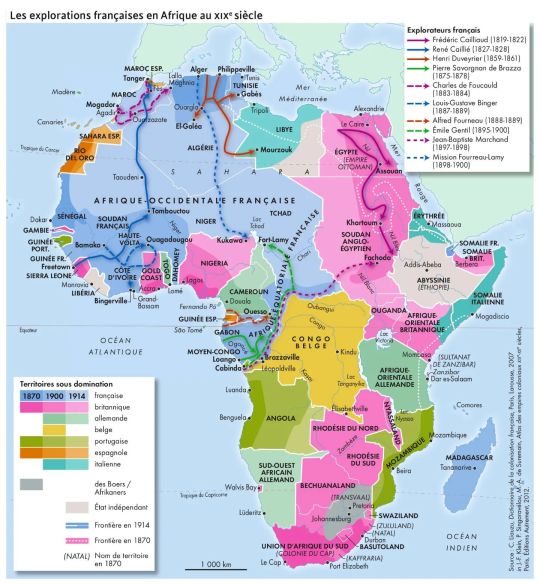
French explorations in Africa in the 19th century
« Nouvel atlas de l'histoire de France », Autrement, 2016
by cartesdhistoire
In the 19th century, a vast movement of exploration of lands unknown to Europeans developed, supported by scientific institutions. The figure of the explorer became familiar to the public, and their stories contributed to the creation of a specific imagination, filled with exoticism and adventure. Perhaps the most evocative name is that of René Caillie, the first Westerner to reach Timbuktu. Another remarkable figure is Pierre Savorgnan de Brazza, a French naval officer born in Italy who explored the Congo (1874-1882).
From the 1880s to the 1890s, European expansion accelerated from sometimes ancient coastal footholds, such as French and British forts in West Africa or Portuguese ones in Angola. The Berlin Conference (1884-1885) set the rules, enforcing effective occupation of land to colonize it. It also guaranteed freedom of movement and trade on major rivers (Niger, Congo). The drawing of colonial boundaries, often complex to define on the ground in densely populated areas, and the colored plaques on the maps should not mask the fact that the appropriation of the territory was progressive and often very loose.
During the conquest, the military consisted of the powers in place (sometimes themselves of European origin, as in the Boer republics of Orange and Transvaal, which eventually became British in 1902). Treaties to share the territories multiplied, which did not avoid crises like the one at Fashoda in 1898, where the French and British clashed for control of the Upper Nile—and more broadly for the completion of their expansion projects: the Dakar-Djibouti link for the French, and the Cairo-to-Cape Town axis for the British. This led to the extension of British influence over the entire Nile basin.
98 notes
·
View notes
Text
I’ve fallen down a rabbit hole of studying the real-life influences that went into the creation/worldbuilding of Nevarra.
For example: Antiva is based off of Italian and Mediterranean influences, Tevinter has Roman Empire vibes, and Orlais has a lot of commonalities with France.
I’m not saying that it these influences have to be 1:1, but I’m a huge anthropology/folklore nerd and it’s fun for my brain to dig deeper into stuff like this. It supports that fantasy is not just an escapist genre, but a method of deeper exploration of the world we already live in. More beneath the cut:
Nevarra is a tricky one. My initial inclinations were to lean toward ancient Egypt as its primary influence. Mostly their reverence for the dead is one that is very tangible. The mages work with corpses and cadavers, all while tending to tombs and cemeteries. A majority of Thedas deal with the concept of death in a spiritual manner, rather than a physical one, due to the nature of Andrastean beliefs.
The food culture is also described to be inspired by North African cuisine. Lots of flat breads, yogurts, and veggies are dominant in their dishes. It’s common for Nevarrans to be vegetarian. The landscape is also implied to be fertile with agriculture. Such connections are similar to that of societies along the Nile river. Beetles are also highly respected as a symbol. Like scarabs, people collect the wings and display them as decor.
While the Egyptian symbolism and archetypes surrounding death may play a big role in the cultural practices, there’s a few things that are also to Central European/Balkan culture. Like the concept of royalty/nobility more closely resembles the political structure of the Austrian empire. There’s mentions of dukes and duchesses being involved in cultural celebrations.
The artistry is also highly appreciated in Nevarran culture. There are so many artisans involved in making jewelry for grave dowries. There’s expert landscapers tending to beautiful memorial gardens. Sculptors that create magnificent statues to honor the stories of the dead. Nevarran art may seem morbid, but brings the subjects of darkness to light. This is a rather gothic approach to artistic expression and appreciation.
I like to think that Mourn Watch! Rook is artistically inclined as well. Even if it is in a way that is seen as dark or morbid.
ANYWAY I’ll probably ramble more about this later but I am interested in how the cultures mix to create a whole new world :3
#dragon age#datv#dragon age the veilguard#mourn watch rook#rook ingellvar#mourn watch#nevarra#ramblings
21 notes
·
View notes
Text

The Nile
The Nile River and the Milky Way The Nile River, winding through the ancient lands of Egypt, has long held a profound spiritual significance to those who have dwelled along its banks. Similarly, the galaxy-spanning Milky Way has captivated humanity’s curiosity and imagination for centuries.
1. The Flow of Life: The Nile River, often referred to as the lifeblood of Egypt, has symbolized the flow of life itself in many spiritual traditions. Just as the river sustains and nourishes the land, it embodies the cycle of birth, growth, and rejuvenation. Similarly, the Milky Way, with its vast expanse of stars, represents the cosmic energy that pulses through the universe and resonates with the ebb and flow of life.
2. Celestial Alignment: Both the Nile River and the Milky Way have been markers for celestial alignment in various spiritual beliefs. The annual flooding of the Nile, synchronized with the rising of the star Sirius, was seen as a divine synchronization, signaling a time of renewal and abundance. In a similar vein, the alignment of stars along the Milky Way has guided celestial navigation and marked significant cosmic events, fostering a connection between the earthly and celestial realms.
3. Reflection and Contemplation: The serenity and tranquility evoked by the Nile River and the Milky Way have provided seekers of spirituality and wisdom with spaces for reflection and contemplation. Egyptians, for instance, believed that the calm waters of the Nile held divine messages and wisdom. The mesmerizing beauty of the Milky Way, stretching across the night sky, has inspired awe and stimulated introspection in cultures around the world, inviting individuals to connect with the vastness of the cosmos and their place within it.
4. Symbolism of Union: In various spiritual contexts, both the Nile River and the Milky Way embody the concept of union or the merging of opposites. The Nile, with its dual nature of both calmness and flood, represents the harmony between opposing forces. Likewise, the Milky Way, often depicted as a bridge or path, symbolizes the unity of the spiritual and physical realms, inviting individuals to merge their earthly and cosmic selves.
Conclusion: The Nile River and the Milky Way, from a spiritual perspective, hold profound meaning and connection to the human experience. Their presence in mythology, rituals, and contemplative practices highlights their timeless significance and the deep resonance they hold within the human spirit. Perhaps, in exploring these natural wonders, we can find inspiration, guidance, and a deeper understanding of our place in the grand tapestry of existence.
45 notes
·
View notes
Text
ANCIENT AFRICA & THE KINGDOM OF KUSH
Ancient African Kingdoms: A Captivating Guide to Civilizations of Ancient Africa Such as the Land of Punt, Carthage, the Kingdom of Aksum, the Mali Empire, and the Kingdom of Kush
CLICK THE TITLE TO DOWNLOAD FOR FREE

ANCIENT AFRICAN KINGDOMS & THE KINGDOM OF KUSH
CLICK THE TITLE TO DOWNLOAD FOR FREE
Ancient Africa: A Captivating Guide to Ancient African Civilizations, Such as the Kingdom of Kush, the Land of Punt, Carthage, the Kingdom of Aksum, and the Mali Empire with Its Timbuktu
The Kingdom of Kush: A Captivating Guide to an Ancient African Kingdom in Nubia That Once Ruled Egypt
Africa is the continent where the first humans were born. They explored the vast land and produced the first tools. And although we migrated from that continent, we never completely abandoned it. From the beginning of time, humans lived and worked in Africa, leaving evidence of their existence in the sands of the Sahara Desert and the valleys of the great rivers such as the Nile and the Niger.
Some of the earliest great civilizations were born there, and they give us an insight into the smaller kingdoms of ancient Africa.
Some of the topics covered in part one of this book include:
The Kingdom of Kush
The Land of Punt
Carthage
The Kingdom of Aksum
The Ghana Empire
The Mali Empire
And much, much more!
Some of the topics covered in part two of this Book include:
Nubia and the emergence of the Kingdom of Kush
From Alara to the Twenty-Fifth Dynasty
The rulers of the Twenty-Fifth Dynasty
Relations between Kush and Egypt continue
Kush between the sixth and third centuries
The Meroitic Dynasty
The last centuries of the Kingdom of Kush
The society of Kush
And much, much more!
Ancient African Kingdoms: A Captivating Guide to Civilizations of Ancient Africa Such as the Land of Punt, Carthage, the Kingdom of Aksum, the Mali Empire, and the Kingdom of Kush
CLICK THE TITLE TO DOWNLOAD FOR FREE
This book is a FREE Download from THE BLACK TRUEBRARY
#ANCIENT AFRICA & THE KINGDOM OF KUSH#Kush#Ancient Africa#African History#THE BLACK TRUEBRARY#Download Free Books#Free Books#Ancient African Kingdoms: A Captivating Guide to Civilizations of Ancient Africa Such as the Land of Punt#Carthage#the Kingdom of Aksum#the Mali Empire#the Kingdom of Kush#KUSH
20 notes
·
View notes
Text

"A boat trip down the ancient River Nile. Snorkeling off the Sinai Peninsula. Exploring the vast Valley of the Kings. Egypt offers enough bucket-list experiences to fill a lifetime. Whatever your dream trip involves, this DK Eyewitness travel guide is the perfect companion.
With a brand-new design, beautiful new photography, and new inspirational content, this fully updated guide brings Egypt to life, transporting you there like no other travel guide. You'll find trusted travel advice, expert-led insights, detailed breakdowns of all the must-see sights, photographs on practically every page, and our hand-drawn illustrations, which take you inside the country's buildings and neighborhoods."
— DK Egypt (Travel Guide)
15 notes
·
View notes
Text
Introduction!
“hello everyone! I’m Coraline, if you don’t know me I’m the main AI of the extra’s universe! Aswell as Caine and buble of course- there are several AU’s to explore here! The mains ones being the superlight universe and my universe, the extra’s universe! Who are basically a collection of abstracted circus members, but before anything, I want to set some ground rules, the expectations and quality of this blog, and what I have to offer for you all!!”

Rules
allows:
I will allow you guys (for entertainment) to have a little go at the characters, like Mynx and Vex
I do animations, free art and some times I’ll answer Ask through art so do not be afraid to ask for some!
there will be times when Ragatha or Gangle will I’ll put a bucket on kingers heads because he is here to, and is one of the main focus’ of the blog, when that happens the bucket will stay on for 5 asks before it goes away,
there will also be times when the ask box is full so I would try to answer them all at once, but it may take me time to think of answers!
be mean to the others all you want. I will play along
Kinger will answer most of the questions, this is a ask Kinger blog after all…
Don’t Allow:
I will not tolerate any harassment, sexism, homophobic’s, bullying, toxic behaviour or any sort of inappropriate behaviour on this blog, there is a reason the Anon asks aren’t on, and that’s because of an incident with @shortmomma1993 , and I’m only being cautious
please take note, that this blog owner is a minor, just around 12, and turning 13 next year, yes I know swear words but please refrain from using them, or asking any inappropriate questions because you will just be blocked
like I said, I do art, but please don’t ask for any inappropriate art works, but I also make edits so that’s up to you if you want to ask, just provide pictures and the style your looking for,
NO HOMOPHOBICS!!! I will not say this enough my friend, I myself am pansexual, and I will not tolerate homophobia, you will be blocked and reported.

Expectations
EXPECTATIONS!!! One I’ve been wanting to do for a while, as you can see this post is already longer the the river Nile, so I’ll make this part short for you!
Remember to expect a bit of gin references, bright images like these:



For reactions, also expect a bit of a father daughter relationship between @ask-pomni-things , the truth is that he adopted her a while back- I’m getting of topic,
ANYWAY! Expect things like art, animations that are quite sketched out, edits, art of my characters from the other AU’s on this blog, I will update the blog often to add more life and style to it, this will start with the profile, I will design these all myself, taking little inspiration from other creators like @chez-cinnamon , @saytrrose , thank you for the amazing art by the way guys-

I believe that’s it? Wait no…
there are a few things I want to say… with relations to other ask TADC blogs, these are the few I’m related to in talking terms
Queenie - @askthequeen
Pomni - @ask-pomni-things
Jax - @ask-jax-the-rabbit
Caine - @ask-teeth-eyes
Zooble - @zooble-the-whatever-i-am
Gangle - @ask-gangle-tadc (I believe? I’ll change it later I promise-)
Ragatha - @sweetragdoll
the circus - @amazing-digital-crew
that’s all!! Have fun here on the blog! I will tag different posts here so you guys can find them just under this line

Kinger head canons
schedule
Know about me?
7 notes
·
View notes
Photo
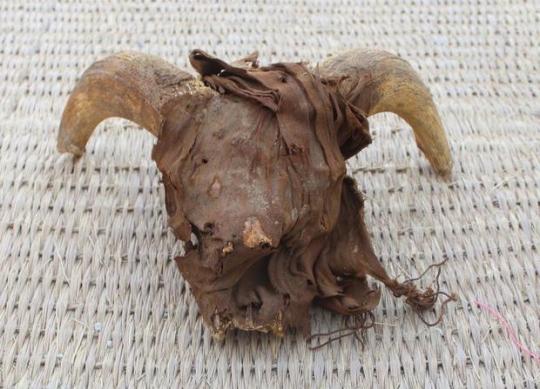
Over 2,000 Ram Skulls Discovered in Egypt's Temple of Ramses II
Cairo — Archaeologists have announced the discovery of more than 2,000 rams' heads at the temple of the ancient Egyptian pharaoh Ramses II — a find that the man in charge of the dig said surprised even veteran Egyptologists and showed the endurance of Ramses' impact, as the skulls were left there a millennium after the pharaoh's rule.
A team of archaeologists with New York University's Institute for the Study of the Ancient World (ISAW) made the discovery in the city of Abydos, one of the oldest cities and richest archaeological sites in Egypt. It's located about seven miles west of the Nile River in Upper Egypt, some 270 miles south of Cairo.
The ram skulls were found stacked in the northern precinct of the temple, said Egypt's Ministry of Tourism and Antiquities, which announced the discovery on Saturday.
"We came across some random pieces of skulls first," Dr. Sameh Iskander, head of the ISAW mission, told CBS News. "We didn't know what they were, but as we continued our excavation and exploration, all of sudden we found a whole area filled with ram skulls."

"These are obviously offerings that were made to the temple of Ramses during the Ptolomaic period, which shows even 1,000 years after Ramses II, that he was still revered." Ramses II ruled over ancient Egypt for about 60 years before his death in 1213 BC.
Iskander explained that some of the ram heads were still mummified, while "others could have been mummified but the wrappings or the covers of mummifications were not there anymore."
The skulls were found among other objects, from papyrus to leather artifacts and statues, about six feet under the contemporary surface of the desert in what had been a storeroom of the ancient temple.
The large number of skulls found in the same place was "surprising even for Egyptologists," Iskander said.
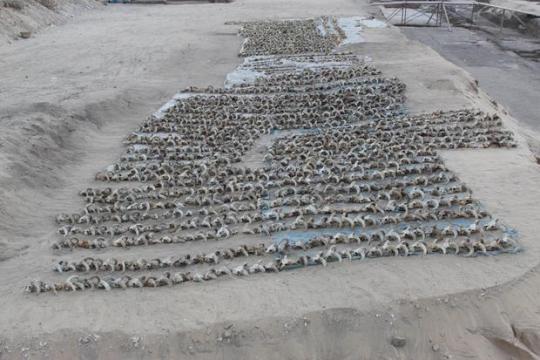
"We are sure they were all dumped at the same time, so this was not an accumulation of skulls that were brought in over the years, but they came from somewhere else and were dumped into this magazine at some point for some reason which we don't know yet," he told CBS News. "It is significant because this place where they ended up is not just any place in the temple, so they were brought there for a reason. They were not just dumped in the desert but were inside this revered domain of the temple."
The archeologists also unearthed a large structure made of mudbricks with walls about 16 feet thick dating back about 4,200 years, to ancient Egypt's Sixth Dynasty.
"It is a major structure that will change our concept of the landscape of Abydos. This wall was built for something, it was at least 30 feet high." Iskander said. "We don't know exactly what this wall is. It's possible that this was a wall of the antient Abydos, which was never found. Could it be something else? Maybe, that's what we are working on now."

The mission also found other mummified animal remains, including dogs, goats, cows and gazelles.
Beside the massive structure, one very small object also captured Iskandar's attention.
"We also found a small bronze bell in excellent condition with the clapper, so we can hear the same sound of the ancient time. I was very happy to find it," he said. "It was probably used to mark a herd."
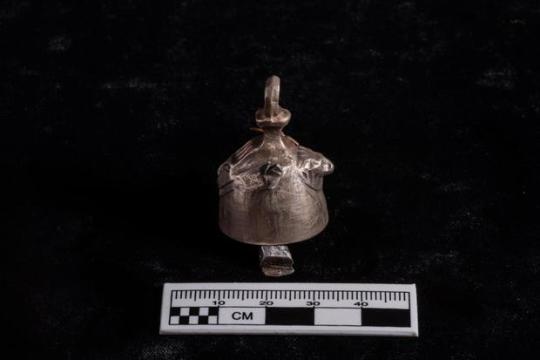
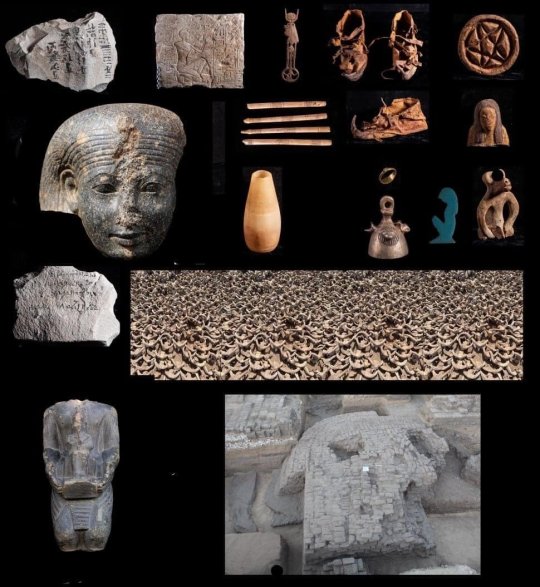
The head of the American mission, whose team has worked at the Abydos site since 2008, spoke to CBS News after traveling back to New York. He said a lot of research was still needed to find explanations for the latest discoveries.
"I hate to keep saying 'we don't know,' but this is the nature of archaeology. We keep working on findings that might lead to something, or not," he said, adding that he and his team may even need to "leave it to the next generation — they may have a better idea or other discoveries."
"Every year we have lots of finds and we come back very happy with the new finds, but we also come back with a huge sack full of questions," he said.
By Ahmed Shawkat.
#Over 2000 Ram Skulls Discovered in Egypt's Temple of Ramses II#city of Abydos#Ptolomaic period#archeology#archeolgst#ancient artifacts#history#history news#ancient history#ancient culture#ancient civilizations#ancient egypt#egyptian history#long reads
175 notes
·
View notes
Text
Luxurious Nile Cruise

Egypt Odyssey: Unraveling Mysteries Along The Nile
Embark on an unparalleled journey through the ancient wonders of Egypt with our exquisite 11-night Nile River cruise and land experience. This meticulously curated adventure includes a 3-night Cairo pre-cruise, a 7-night roundtrip cruise from Luxor, and a 1-night Cairo post-cruise, offering an all-encompassing exploration of Egypt's most iconic sights.
Day-by-Day Itinerary
Day 1: Cairo Begin your journey in Cairo, where you'll be greeted by our representative who will assist with your luggage and customs. Relax and settle into your luxury hotel, enjoying the first glimpses of the Nile from your partial view room.
Day 2: Cairo Dive into Egypt's rich history at the Egyptian Museum, home to King Tut's treasures and a vast collection of artifacts. After a local lunch, visit the Alabaster Mosque at the Citadel of Saladin, offering panoramic views of Cairo. Conclude your day with a Welcome Reception featuring tapas and drinks.
Day 3: Cairo Explore the ancient capital of Memphis, a UNESCO World Heritage Site. Marvel at the Pyramids of Giza, the Great Sphinx, and the necropolis of Sakkara. Enjoy a delightful lunch at the historic Mena House Hotel, followed by a leisurely evening.
Day 4: Cairo to Luxor Fly to Luxor, the ancient city of Thebes, and embark on your luxurious river cruise ship. Enjoy a Captain’s Welcome Cocktail as you prepare for the adventures ahead.
Day 5: Luxor Visit the Valley of the Kings and Queens, including a private tour of Queen Nefertari’s Tomb. Continue to the Temple of Hatshepsut and the Colossi of Memnon. In the evening, relax on the Upper Deck or join an informal cooking class.
Day 6: Edfu Discover the Temple of Horus in Edfu, one of Egypt’s best-preserved temples. Enjoy the timeless landscapes of the Nile as the ship cruises towards Aswan.
Day 7: Aswan Opt for a free morning or an excursion to Abu Simbel, a UNESCO World Heritage Site. Later, take a felucca ride around Elephantine Island and consider an afternoon tea at the historic Old Cataract Hotel. End the day with a belly dance show on board.
Day 8: Aswan to Esna Visit the Philae Temple complex and a Nubian village on Hisa Island. Continue to the Great Temple of Kom Ombo, dedicated to Sobek and Haroeris. Celebrate local customs with a Galabeya Party on board.
Day 9: Esna to Luxor Cruise to Luxor, visiting the Temple of Karnak and a papyrus shop. Explore the Temple of Luxor and the vibrant Luxor Market.
Day 10: Luxor to Qena to Luxor Sail to Qena and visit the Temple of Hathor in Dendara, the best-preserved temple in Egypt. Return to Luxor for the night.
Day 11: Luxor to Cairo Disembark in Luxor and fly back to Cairo. Enjoy an exclusive tour of the Abdeen Presidential Palace, followed by a special lunch. Explore Coptic Cairo, including the Hanging Church and Ben Ezra Synagogue.
Day 12: Cairo Bid farewell to Cairo as you prepare for your flight home, completing an unforgettable journey through Egypt's ancient wonders.
Luxurious Accommodations and Amenities
Cairo (Pre-Cruise)
Arrival airport transfer
3 nights in a luxury hotel with a partial Nile view room, daily breakfast, and complimentary Wi-Fi
Full-day Cairo tour with visits to the Egyptian Museum, Citadel of Salah Ed-Din, and Alabaster Mosque
Visit to the Pyramids of Giza, the Great Sphinx, and Saqqara Museum
Lunch at the historic Mena House Hotel
Nile River Cruise
7-night river cruise in elegantly appointed accommodations
Fine dining options, including The Al Fresco Restaurant
Wine, beer, and soft drinks included during lunch and dinner
Sip & Sail cocktail hour, Welcome Cocktail, Welcome Dinner, and Gala Dinner
Dedicated English-speaking Egyptologist guide
Nightly entertainment, including belly dance shows and a Galabeya Party
Guided shore excursions and exclusive visits to historical sites
Onboard amenities: fitness room, sun-deck pool, hair and nail salon, massage room, and complimentary Wi-Fi
Cairo (Post-Cruise)
1 night in a luxury hotel with a partial Nile view room, breakfast, and complimentary Wi-Fi
Visits to the Hanging Church and Ben Ezra Synagogue
Exclusive private tour and lunch at the Abdeen Presidential Palace
Departure airport transfer
Optional Extensions
Enhance your adventure with a 3-night pre-cruise extension in Dubai, exploring the vibrant city known for its luxury shopping, modern architecture, and lively nightlife.
Conclusion
Experience the timeless allure of Egypt on our luxurious river cruise. From the bustling streets of Cairo to the serene landscapes along the Nile, this journey offers a unique blend of history, culture, and luxury. Explore iconic sites like the Pyramids of Giza, the Valley of the Kings, and the Temple of Luxor, guided by expert Egyptologists. Indulge in fine dining, exclusive experiences, and world-class service throughout your adventure. Join us for an unforgettable exploration of Egypt's ancient secrets and modern marvels with Savvy Travelers. Unlock the mysteries of this captivating land with our Egypt Odyssey!
#egypt nile river cruise#egypt nile cruise#luxurious nile cruise#nile river cruise#cairo exploration tour#pyramids giza visit#valley kings excursion#egyptian museum tour#alabaster mosque visit#sakkara necropolis tour#mena house experience#hatshepsut temple exploration#colossi memnon sightseeing#edfu temple discovery#aswan felucca ride#abu simbel excursion#cataract hotel tea#philae temple visit#nubian village tour#kom ombo visit#karnak temple exploration#luxor market shopping#hathor temple tour#dendara temple visit#abdeen palace tour#coptic cairo exploration#welcome reception cocktail#gala dinner experience#egyptologist guided tour#exclusive shore excursions
0 notes
Text




November 10th 1871 saw the Journalist Henry M Stanley find the missing Scottish missionary David Livingstone with the classic “Dr Livingstone, I presume?”
In 1867, Henry Stanley became special correspondent for the New York Herald and two years late would be sent to Africa in search of the legendary explorer David Livingstone.
Livingston had been following his obsessional search to find the sources of the Nile River and no one had heard from him for three years.
Stanley got to Zanzibar in 1871 and headed out on a 700 mile trek through tropical rainforest. Because the Herald had not sent the money promised for the expedition he borrowed in from the US Consul. He used this cash to hire over 100 porters for the expedition.
The trip did not go well. During the expedition through the tropical forest, his thoroughbred stallion died within a few days after a bite from a tsetse fly. Many of his porters deserted, and the rest were decimated by tropical diseases.
Seven months after arriving in Zanzibar Stanley found Dr Livingstone near Lake Tanganyika in present-day Tanzania and greeted him with the famous quote: “Doctor Livingstone, I presume?” Or did he?
There is some doubt about whether the line was actually ever said.
Pages that relate to their meeting were torn out of Stanley’s diary by the man himself and neither he nor Livingstone mentioned them in their letters.
It surfaced over a year later in a summary of Stanley’s letters in The New York Times.
When Livingstone died a few years later Welshman Stanley continued to explore huge amounts of central Africa.
The rest of his career was just as eventful.
He was a key part in opening up the lower Congo to trade which meant the creation of the Congo Free State under King Leopold II of Belgium.
Despite his supposed famous line and explorations giving him his place in history there have been a number of criticism levelled against him.
He was accused of indiscriminate cruelty against African even saying himself: “Many people have called me hard, but they are always those whose presence a field of work could best dispense with, and whose nobility is too nice to be stained with toil.” It is also argued that he had a very conflicted view of women describing them as “toys” and “trifling human beings”.
Livingstone died from dysentery and malaria on May 1st, 1873, at the age of 60, in Chief Chitambo’s Village, near Lake Bangweulu, North Rhodesia (now Zambia).
10 notes
·
View notes
Text
Spooky Book of the Week: Fantasy Farm

Author: Xī Zǐxù (西子绪) / ซีจื่อซวี่ (thai)
Genre: horror, supernatural, slice of life, danmei
Rating: T for the Nile (not just a river in Egypt)
My Synopsis: Man who moves back to his home village and discovers that nothing around him is normal thinks that he is, in fact, normal. Lol. Lmao even.
My Review: If the other spooky month recs have been a tad bit too spooky, this might be the novel for you! A lot of the plots lean heavily into the supernatural without the scare factor (lowkey starts to feel like a Studio Ghibli movie in the latter 2/3rds of the novel). But before I get too deep into this: this novel is heavy on the slice-of-life, as in it does not feel like much is driving the plot further other than "MC lives his life." It's not bad (I am obviously reccing it, lol) but if you're looking for adventure and consistent plot movement, then this one may not be for you. In a way, it kind of reminds me of the anime Mushi-shi (if you've never seen it, check it out!) where some episodes are horror, some episodes are chill, but the whole show is just about humans dealing with the inconvenience of living beside the supernatural. On another note, if you are someone easily tempted by depictions of food, this novel will either make you very happy or very angry. Almost every chapter discusses a new Chinese dish, and the translators were oh so very kind enough to include pictures of each one at the very end. One even started adding the recipes at the end. All in all, I really enjoyed the slow pace of this despite how frustrating Lu Qingjiu's ironclad self-restraint and lack of curiosity made me. (I mean c'mon dude, you can't be in a horror novel and then not explore the horror! You can't have a sense of self preservation and respect of personal boundaries when mystery is afoot! Do you not know what genre you're in?!) Can't wait for the cookbook to drop!
Translation: complete
#human promotes#fantasy farm#this is only my second slice of life novel#the first one also being about an mc minding her own business to farm LOL#wasn't sure if anyone cared for those so i was unsure if i should rec it#but what the hell: 'novel where nothing* happens' can be a nice change of pace sometimes lol#*the nothing of course just being regular neighborhood gossip and small daily inconveniences#(things do indeed start happening later but things are very chill for a long while)#this novel is also much longer than it seems#because every chapter is actually split in 2#it is not a quick read
7 notes
·
View notes
Text
It's impossible to overstate the importance of the Nile for ancient and modern Egypt. It's interesting to learn how it has shifted over time, and not just in the Delta.
18 notes
·
View notes